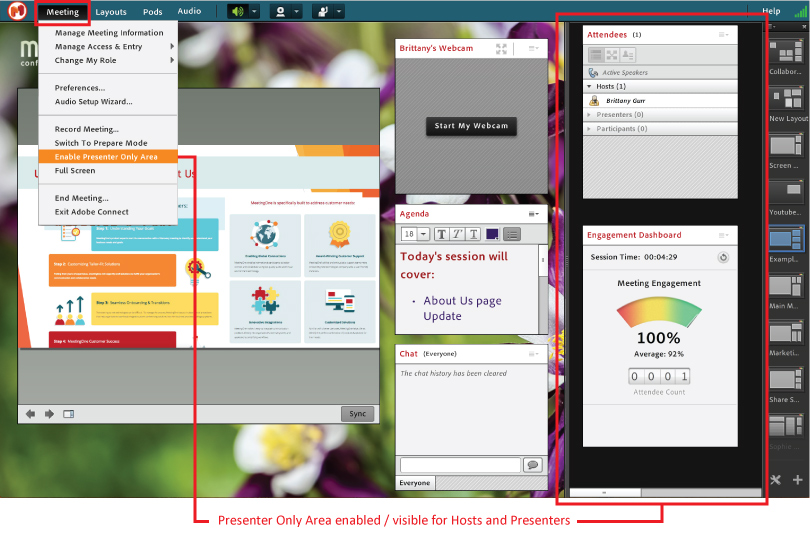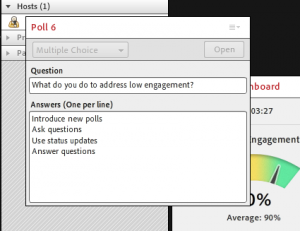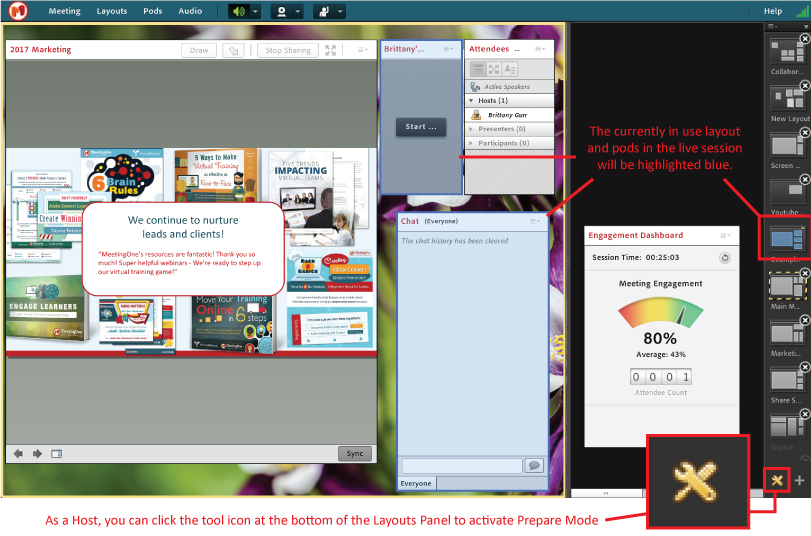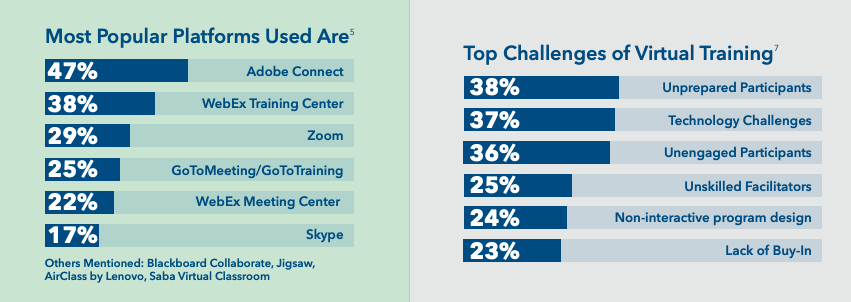The Revolution in Artificial Intelligence (AI) is on our doorstep. Some say it will disrupt society in ways we can hardly imagine. It’s been viewed as a threat to jobs from burger flippers to brain surgeons. So…should we start panicking today…or tomorrow?
While AI will certainly change the way we work, much of the work it will assume will be more analytics aligned. Ultimately, AI technologies have the power to complement our jobs and give us powerful insights to assist our work.
However, if you still have concerns like many others do, the best defense is often good offense: Build out your job skills. Make yourself stand out. Be irreplaceable.
Nowhere is this truer than in training and development.
To help training and development professionals prepare for the future, LinkedIn Learning surveyed 4 Experts on the skills they think will best serve this group in the next 5 years.
In this blog, we are going to explore two of these skills we believe to be most important. And we have a few extra thoughts for those of you wondering about the future of online training. Our advice: Get good at live online training.

4 Skills for the Future of Training and Development
LinkedIn Learning connected with four terrific experts in the training and development field:
- Doug Lynch, a Ph.D. and longtime education researcher who has worked with colleges like the University of Pennsylvania to build their PennCLO program.
- Rose Else Mitchell, CLO at Houghton Mifflin Harcourt.
- Kimberly Devlin, managing director of EdTrek Inc.
- Dan Rice, a West Point graduate and president of the Thayer Leadership Development Group.
These experts were asked which skills they thought would be most important to training and development professionals in the next five years. They landed on four biggies they feel will be important in the coming five years:
- Strategy: Companies will need employees to learn skills faster in the future. For this to be possible, trainers will have to be strategic about using their time. The content they deliver must be effective and fit with larger company goals.
- Learning about Learning: Understanding how adults learn will become critical to trainers everywhere. The experts noted that too few people spend their time learning about learning. (Here’s one of our resources for training adults!)
- Technologically Savvy: Technology makes training many employees easier, but it’s critical to identify the right one to use and become a virtuoso with that tool.
- Becoming more Data Driven: While tieing training results to business success can be hard, trainers have to find a solution. The first step is ensuring you use tools that provide powerful metrics on training success.
When we looked at this list, we were fascinated by the last two in particular. Being tech-savvy and data-driven are at the core of the modern workplace. Employees and businesses that manage both will weather any storm!
As the experts noted, “…there are many L&D tools out there, and yet only a few provide real value to employees.” Finding the tech that can cover multiple needs should be a priority of all training and development professionals.
Furthermore, technology makes training more efficient. Many tools allow learners to learn on the go and at their leisure. Technology is also connecting teams around the globe and making dispersed training the new reality.
As for being data-driven, it’s hard to argue against the importance of knowing how to interpret data. Using data well is the best way for trainers to show the value of learning in employee outcomes. The better employees perform, the more likely a business will have success.

Insightful data can also help trainers pinpoint shortcomings in their material. Maybe some of the content isn’t quite connecting. How does a trainer know this if learners stay quiet? Good data will provide the answers!
While we agree with the importance of all four skills, we want to add a caveat. Training and development professionals should also acquire creative skills that can’t be replaced by an AI system.
We should all look at AI as an opportunity to leverage its computing power. Once we have, creative skill sets will be the natural heir in the workplace. If we look at AI with a positive outlook, we will see that it presents us the opportunity to pursue work that demands we be imaginative and inventive! Both are important to training and development.
So, this brings us to a key point: Jobs that require creativity and human-to-human interactions can’t be replaced! The same is true of the virtual setting and live online training.
That’s why we believe training and development professionals should aim to be quality online trainers, too.
.
Why the Future is Bright with Live Online Training
One of the best parts about training in the future is you will get to train teams on skills that will increase their job security! Trainers everywhere are in the best positions to encourage employees to develop essential creative and analytical skills. Which is awesome!
Becoming a trainer skilled in the live online training paradigm takes practice. You have to become technologically savvy, innovative, able to interpret data, and always on top of your game.
Fortunately, being an online trainer will pay off! Like we mentioned above, live online training is not the type of thing you can simply pass off to a robot. It requires ingenuity, wit, and creativity – none of which can be programmed easily. Live online training cannot be easily replaced – and that will help you stand out in the future.

More and more businesses are moving to online training for any number of reasons.
- More remote employees.
- Higher satisfaction when training international teams.
- Reduced costs over in-person.
Developing skills as an online trainer depends on many things. We believe the most important thing is to be competent in the platform you use.
In the rest of this blog, we’ll explore how Adobe Connect represents the best example of a virtual classroom platform trainers should come to master and love. It has nuanced features that provide for better learning experiences. It also provides back-end reporting that is comprehensive. Learning to use the platform puts the onus on being creative.
 Adobe Connect: Ideal for Live Online Training
Adobe Connect: Ideal for Live Online Training
Adobe Connect is unique in so far as its functionality is nuanced. It gives you the ability to develop virtual classrooms with a human touch. Let’s look at the elements of Adobe Connect that make it undeniably powerful.
Configuring Rooms
Each and every pod in Adobe Connect can be placed anywhere in the room and stretched to any size. Need to feature just a Screen Share during online training? Easy enough! Other pods can be “hidden,” then the Share Pod can be scaled to fit the entire room.
The same is true for every Adobe Connect Pod. Webcams, chats, notes – every pod can be sized and positioned to fit your needs. Talk about truly customizable online training.
There are obvious benefits for training use cases. Trainers who want their virtual space to conform to the content can easily do so. For sessions that are lecture heavy, a trainer can feature just the Share Pod and webcam feeds. If it’s a time to move to a group discussion, an additional chat can be added in seconds. Want to drive engagement? You can place multiple polls to spark interactions.
(Example of adjusting pods to your needs.)
Shaping these pods and placing them so they fit your needs requires a bit of artistry. Balancing and aligning pods can enhance participant experiences, and the right symmetry can help focus attention and guide interactions.
The choices a trainer makes in Adobe Connect are often nuanced and subtle. Yet, they translate to a better final product. That’s using tech savviness and achieving great results. It’s hard to replace a deft hand!
Building Layouts
So, we know every pod can be moved around and placed anywhere. Then they can be sized up or down. But it doesn’t stop there. Each Adobe Connect room comes with an unlimited number of Layouts, and each functions like a focused classroom.
In one layout, you could feature only a Share Pod for lecturing purposes. The next layout could include more interactive elements, like a Chat or Poll. You can have as many Layouts as you’d like. Or you can keep it simple and use the 3 that come with Connect when you create a room.
Layouts allow users to transition between parts of their training based on the content. Sometimes, a training has to be a bit lecture-heavy. Other times, driving engagement is what matters. Moving between layouts makes this smooth and fluid.
(Example of transitions between layouts.)
Let’s consider an example. A trainer has been explaining the workflow of software dev to new hires. Rather than stop the entire flow of the training to poll, they could move to a Layout that features the presentation AND a short-answer poll. The result is better: Less disruption, less confusion. This is something we see trainers often do.
Online trainers can build out custom online training by using different layouts for the different sections of your material.
However you use Layouts, they truly offer you the ability to tailor your training. The planning involved requires a lot of forethought about your material and audience needs. That type of thoughtfulness is a skill unto itself.
Live Editing
Adobe Connect allows trainers access to an exclusive space during events: the Presenter Only Area. It’s basically a “Backstage Area” or “Green Room.” The Presenter Area cannot be seen by participants, and it also offers trainers a place to observe participant engagement in secret.


The best feature of the Presenter Area is that new Chat and Poll pods can be created here without being seen by participants. This allows trainers to react to conversations during a session and add interactive elements on the fly.
Let’s consider an example. A trainer has a group of learners watch a video. During the video, the trainer wants to get the team immediately engaged after it ends. They could create a poll based on the presentation – in the Presenter Area! After the video concludes, they could place the poll in the room and spark interactions!
We’ve heard a number of stories about teachers and trainers alike using this functionality to re-engage their audience.
The other side of Live Editing is the management of Layouts with the Prepare Mode.
The Prepare Mode in Adobe Connect gives trainers the ability to adjust layouts during live online training – behind the scenes. The Prepare Mode isolates Layouts for trainers to navigate through and adjust without being seen by anyone else in the room.
Let’s say you are in Prepare Mode and select a Layout later in the presentation. Although Adobe Connect will take you directly to that Layout, learners will remain at the same stage of the presentation and in the same layout. You can then edit a layout, add a pod, or manage/update documents without interrupting the presentation. Exiting prepare mode is just as easy.

While live editing may seem advanced, it doesn’t require much practice to get the hang of. And once you learn it, well, that’s next level training. Spontaneity + tech-savvy = a powerful skill set.
Post-Training Reporting
Adobe Connect provides some of the most comprehensive reporting on training in the industry.
Adobe Connect reports on a substantial amount of information. Like many other platforms, it compiles who and how many people answered poll questions. It also tracks the total number of chats during a session, and the questions asked vs. answered in the Q&A pod.
The reporting of Adobe Connect comes back to the Engagement Report. Adobe Connect’s engagement report far surpasses that of other platforms, which only track the time a training room is a primary window on a computer screen.
After your training, you receive an insightful report comparing the levels of engagement and attendance with the presentation time. Adobe Connect gives a minute-by-minute breakdown of engagement. The specificity provided allows you to know when engagement dips and content may need to be refined.

Savvy trainers can use all of this information to determine better how the content is being received. Sudden dips in engagement can help trainers plan to incorporate an interactive feature to buoy interest for future online training.
Knowing how to run live online training in Adobe Connect gives every training and development professional a leg up. You can check off being tech-savvy and data-driven using one platform!
Start Planning for Tomorrow
We shouldn’t look at AI as a boogeyman waiting for us around the next corner. Various intelligent systems will help trainers better gather and process data. AI will make the more analytical side of work easier in all likelihood. And this leaves plenty of room for we humans to be creative!
We should finish by noting that Adobe Connect was the top Virtual Classroom software used by trainers in 2019. Cindy Hugget’s survey found that 47% of trainers use Adobe Connect.

You don’t have to worry about it being siloed for live online training. Adobe Connect also integrates with most LMS platforms, and its advanced recording functionality makes it desirable for your on-demand library of videos.
Future-proof your work – and the work of those you train! Live online training with Adobe Connect may be the answer for many in training and development!
If you’re ready to build out your skillset in the platform made for creative people, take some time to explore Adobe Connect virtual classrooms today!






